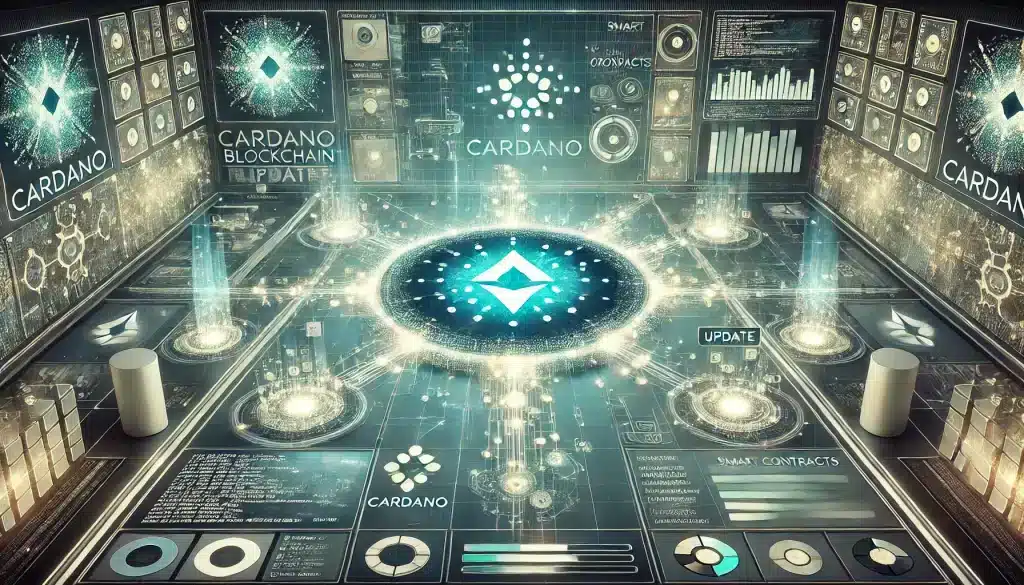Cardano Strengthens Blockchain Leadership with New Update by Blinken Labs

Cardano Strengthens Blockchain Leadership with New Update by Blinken Labs
The “docker-cardano-cli v8.24.0.0-1” update developed by Blinken Labs and released on June 15, 2024 brings several improvements to the Cardano command-line interface, particularly enhancing its functionality within Docker environments.
It also shows Cardano’s high level of development activity to help maintain a robust and secure blockchain platform, which is crucial for its adoption and success in the competitive blockchain space.
New Release: docker-cardano-cli v8.24.0.0-1
— Cardano Updates (@cardano_updates) June 22, 2024
Check it out here: https://t.co/goJr8irxrz
Released by github-actions[bot] – blinklabs-io#Cardano $ADA #Koios
What It Means and What It Does
- Enhanced CLI Functionality: The update brings new commands and options to the Cardano CLI, making it more powerful and versatile for developers and node operators. For instance, the new transaction echo command is one of the features introduced.
- Docker Integration: By improving the Docker compatibility, it allows developers to more easily deploy and manage Cardano nodes in containerized environments. This simplifies the setup and maintenance of nodes, facilitating smoother updates and scalability.
- Improved Performance and Reliability: The update includes several performance enhancements and bug fixes that contribute to the overall stability and efficiency of the Cardano network.
Advantages
- Streamlined Development: The enhanced CLI tools streamline the development and deployment processes for applications built on Cardano. This is particularly beneficial for developers using Docker for consistent and isolated development environments.
- Scalability and Maintenance: Improved Docker support means that scaling up the number of nodes or making updates is more straightforward and less prone to errors. This leads to better maintenance practices and reduced downtime.
- Increased Adoption: By making the tools more accessible and easier to use, Cardano is likely to attract more developers to its ecosystem, fostering innovation and growth.
Strengthening Cardano’s Position
As of 2024, Cardano holds a strong position in the blockchain space, with a robust usage and adoption across various domains.
- Total Value Locked (TVL): Cardano has seen a notable increase in TVL within its DeFi ecosystem. As of the third quarter of 2023, Cardano’s TVL grew by 198% year-to-date, positioning it as the 15th largest blockchain by TVL. This growth is largely driven by increased stablecoin usage and the activity of key players like iUSD and DJED, which contributed to a stablecoin market share increase from $50 million to over $200 million.
- DeFi and Stablecoins: The network has seen a 16% growth in stablecoin usage in the past quarter, reflecting a 461% increase since the beginning of the year. This surge is attributed to enhanced stablecoin protocols and integrations, such as Wanchain, enabling broader access to mainstream stablecoins like USDT and USDC.
- Smart Contracts and DApps: With the Goguen update, Cardano introduced smart contracts and a multi-currency ledger, significantly boosting its ability to support decentralized applications (DApps). This phase increased Cardano’s attractiveness to developers and private companies, contributing to its growing ecosystem.
- Governance and Decentralization: The ongoing Voltaire phase is focused on decentralized governance, allowing ADA holders to participate in important decisions through a structured voting mechanism. The introduction of CIP 1694 and the establishment of Intersect further enhance Cardano’s governance, making it more community-driven.
- Technological Innovations: Cardano continues to innovate with projects like Hydra for scalability, Midnight for privacy-focused applications, and Mythrill for improved wallet synchronization. These advancements ensure Cardano remains competitive and capable of handling increased demand and complexity in blockchain applications.
Chronological Overview Updates from Cardano
Here is a chronological overview of all the significant updates from Cardano, divided into its major development phases:
1. Byron (Foundation Phase)
- Launch Date: September 2017
- Key Features:
- Introduction of the ADA cryptocurrency.
- Release of the Daedalus wallet.
- Establishment of the core infrastructure for Cardano’s blockchain.
2. Shelley (Decentralization Phase)
- Launch Date: July 2020
- Key Features:
- Transition to a fully decentralized network.
- Introduction of staking and delegation.
- Implementation of Ouroboros Praos, an improved PoS consensus algorithm.
3. Goguen (Smart Contracts Phase)
- Key Milestones:
- Allegra Hard Fork: December 2020: Enabled token locking, a prerequisite for smart contracts.
- Mary Hard Fork: March 2021: Allowed the creation of native tokens on Cardano.
- Alonzo Hard Fork: September 2021: Enabled smart contract functionality with the introduction of Plutus scripts.
4. Basho (Scaling Phase)
- Key Focus: Enhancing scalability and interoperability.
- Key Innovations:
- Hydra: A layer 2 scaling solution for off-chain transactions.
- Sidechains: Enabling parallel processing to offload work from the main chain.
- Pipelining: Improving transaction throughput by processing multiple transactions in parallel.
5. Voltaire (Governance Phase)
- Key Focus: Implementing a decentralized governance system.
- Key Features:
- Catalyst Project: A decentralized funding mechanism allowing the community to propose and vote on projects.
- CIP 1694: Introduced liquid democracy, enabling direct community participation in governance.
- Intersect: A member-based organization ensuring Cardano’s continuity and decentralized development.
Technological Innovations
- Ouroboros BFT: Improved synchronization and decentralization, preparing for Shelley.
- Ouroboros Genesis: Simplified chain selection and node bootstrapping.
- Ouroboros Chronos: On-chain clock synchronization for better network time management.
- Midnight: A privacy-focused sidechain using zero-knowledge proofs for secure transactions.
- Mythrill: Enhances wallet synchronization and improves network scalability.
What is The Competition Doing?
Cardano faces competition from several notable blockchain platforms in the industry, each offering unique features and advantages. The platforms we list below represent the most important competitors to Cardano.
- Ethereum: As the pioneer of smart contracts and decentralized applications, Ethereum remains a major competitor. Its transition to Ethereum 2.0 aims to enhance scalability and energy efficiency, maintaining its dominance in the blockchain space.
- Polkadot: Known for its focus on interoperability, Polkadot enables different blockchains to connect and communicate seamlessly. Its unique architecture, which includes “parachains” for parallel processing, addresses scalability issues effectively.
- Solana: Renowned for its high transaction speeds and low costs, Solana leverages a combination of Proof of History (PoH) and Proof of Stake (PoS) mechanisms. This makes it a strong contender, particularly in the decentralized finance (DeFi) and decentralized applications (DApp) sectors.
- BNB Smart Chain (BSC): Developed by Binance, BSC is a high-performance network that supports advanced DApps and smart contracts. Its compatibility with the Ethereum Virtual Machine (EVM) allows for seamless integration and interoperability with Ethereum’s network.
- Algorand: Algorand focuses on delivering an energy-efficient blockchain platform, appealing to users and developers concerned with environmental sustainability. Its Pure Proof of Stake (PPoS) consensus mechanism ensures quick transaction processing and low fees.
- Avalanche: Prioritizing speed, security, and decentralization, Avalanche utilizes a novel consensus protocol that enables high throughput and fast finality. It is designed to overcome some of Ethereum’s scalability and speed limitations.
- Tron: Aiming to create a decentralized digital entertainment ecosystem, Tron focuses on providing a platform for content creators and consumers. Its high throughput and low transaction fees make it suitable for applications such as gaming and digital content distribution.
- Near Protocol: Near Protocol emphasizes developer-friendly features and scalability, making it an attractive option for building decentralized applications.
Basically, the more developments (even in other blockchain platforms) the better as it pushed Cardano to go even further.







